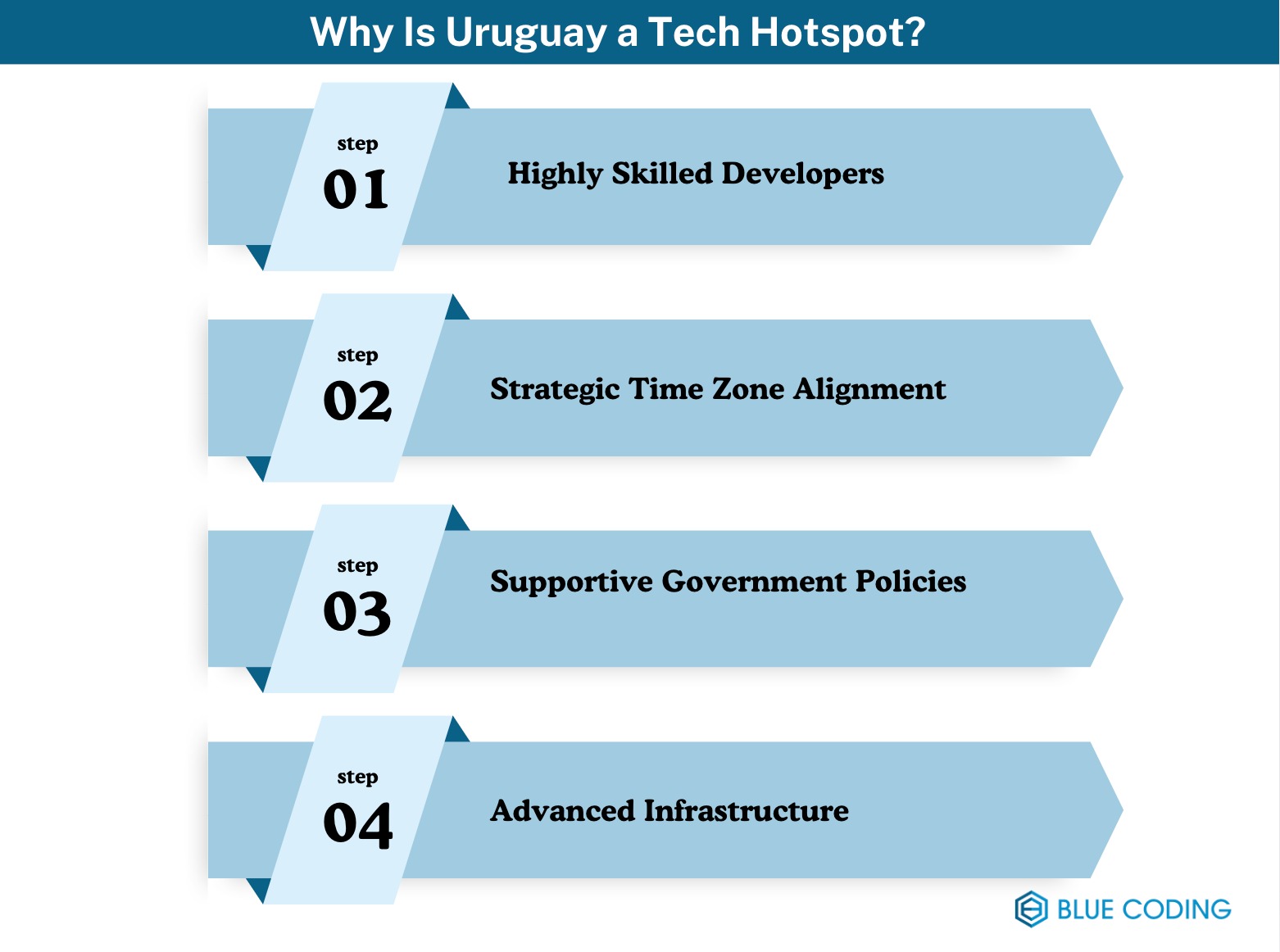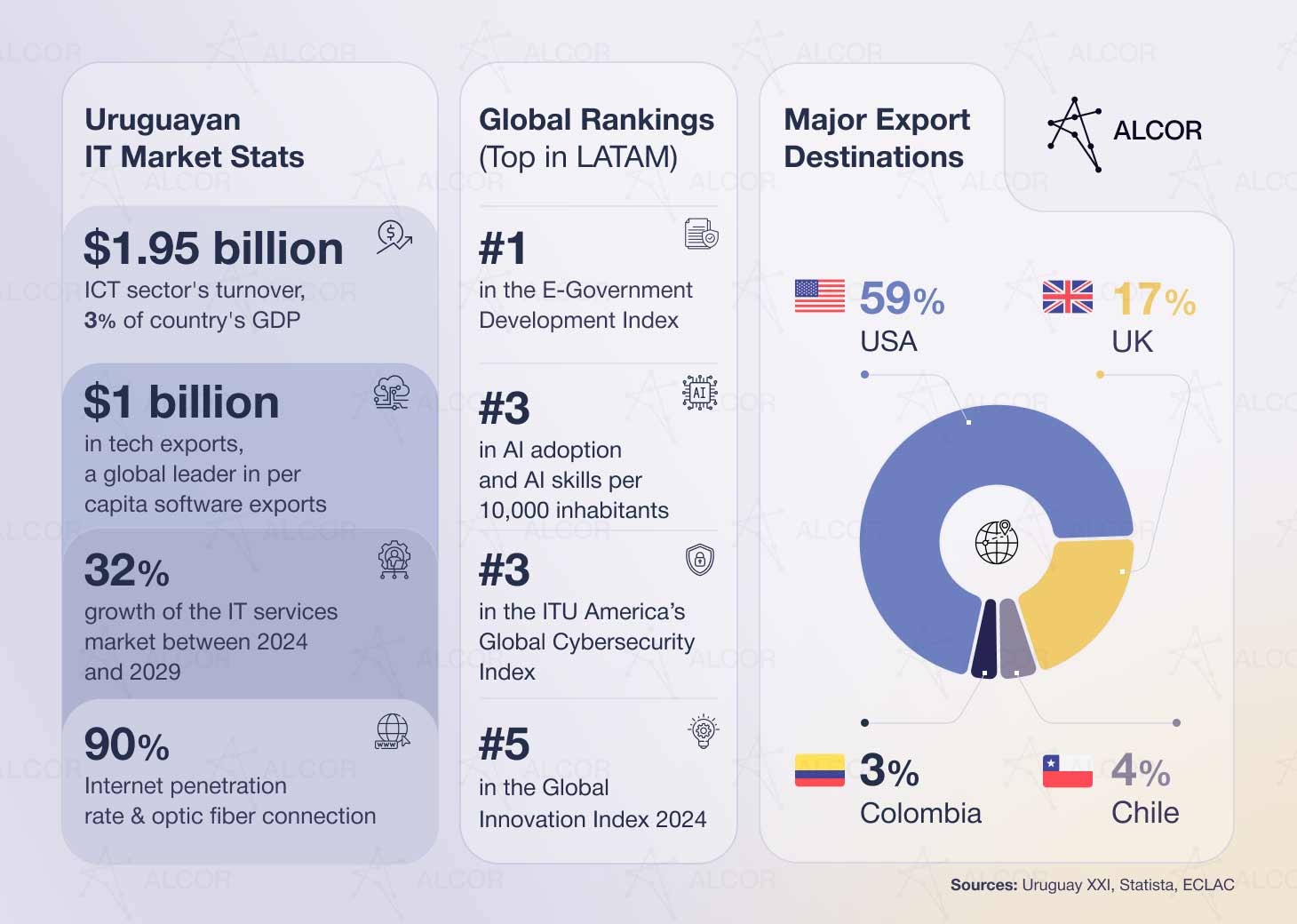 News
News
Uruguay is a small country in South America, but it is making a big name for itself in the technology world. Developers in Uruguay are skilled, innovative, and often work on global projects. The country has a growing tech industry because of its strong education system, government support, and tech-friendly culture. Many companies around the world choose Uruguay as their outsourcing destination because of the high quality of work. In this article, we’ll look into the most popular tech stacks in Uruguay. These tech stacks are combinations of programming languages, frameworks, and tools that developers use to build apps, websites, and software. Be sure to also check out our post on how to setup a BOT development center in Uruguay.
What Is a Tech Stack?
Before we talk about specific tech stacks, let’s understand what a tech stack is. A tech stack is the set of technologies used to develop software or applications. It is like a toolbox for developers, helping them build functional and efficient software.
A tech stack has two main parts:
1. Front-End (Client-Side): This is the part of the application that users see and interact with, like buttons, images, and menus. It uses tools like HTML, CSS, and JavaScript.
2. Back-End (Server Side): This is the hidden part of the application. It handles logic, databases, and the server. Common tools include Python, PHP, and databases like MySQL.
Choosing the right tech stack is important because it affects how the software works, how fast it is, and how easy it is to maintain. For example, using a strong and reliable tech stack makes it easier to handle many users at once or add new features later.
Why Is Uruguay a Tech Hotspot?

Highly Skilled Developers:
Uruguay is home to a pool of exceptionally talented developers who are proficient in modern programming languages, frameworks, and tools. This expertise is the result of a robust educational system that emphasizes STEM (Science, Technology, Engineering, and Mathematics) fields, as well as continuous professional training initiatives.
Strategic Time Zone Alignment:
The country’s geographic location places it in time zones closely aligned with those of North America. This overlap facilitates seamless communication and real-time collaboration between Uruguayan developers and businesses based in the United States and Canada, making it an attractive nearshoring destination.
Supportive Government Policies:
Uruguay’s government has implemented policies designed to bolster the tech sector. These include significant tax incentives for technology companies, investments in technology education, and initiatives to attract foreign investment. Such measures have created an ecosystem that encourages entrepreneurship and international partnerships.
Advanced Infrastructure:
Uruguay’s quality infrastructure supports its growing tech industry. The country boasts one of the most reliable high-speed internet networks in Latin America, as well as modern facilities equipped to handle the needs of technology companies and remote work environments. These factors enhance productivity and ensure efficient operations for businesses operating in or outsourcing to Uruguay.
10 Popular Uruguayan Tech Stacks
In this section, we observe a detailed list of tech stacks in Uruguay and what makes each tech stack stand out to Uruguayan developers.
1. JavaScript and Its Frameworks
JavaScript is one of the most popular programming languages in Uruguay. Developers love it because it can be used for both front-end and back-end development. This means a single programming language can power the entire application.
Frameworks Used: In Uruguay, popular JavaScript frameworks include React, Angular, and Vue.js. These frameworks make it easier to build modern, interactive websites and apps.
Common Uses:
React is often used for building user interfaces.
Angular is great for large-scale projects.
Vue.js is popular for simpler, smaller apps.
Why Developers Like It: JavaScript is versatile, has a large community, and works well for building websites, mobile apps, and even games.
2. Python with Flask and Django
Python is another favorite among Uruguayan developers. It is known for being simple and powerful, which makes it a great choice for beginners and experts alike.
Frameworks Used:
Flask: A lightweight framework for simple web applications.
Django: A more powerful framework for larger projects.
Why It’s Popular:
Python is easy to learn, has a lot of libraries (pre-built tools), and can be used for many purposes, like:
Web development.
Data analysis and visualization.
Machine learning and AI.
Examples of Use: Companies use Python to build websites, manage data, and create AI-based solutions like chatbots.
3. Java with Spring Boot
Java has been around for decades, but it’s still very popular amongst businesses that opt for outsourcing to Uruguay. . It is often used for large, complex projects.
What Is Spring Boot? Spring Boot is a Java framework that simplifies creating web applications. It is especially useful for enterprise-level software.
Key Features:
Java is highly secure and reliable.
It works well for applications that need to handle a lot of users.
Industries Using Java in Uruguay: Banks, insurance companies, and healthcare providers rely on Java for secure and efficient software solutions.
4. .NET with C#
.NET, combined with the programming language C#, is widely used in Uruguay for building apps and websites. It is backed by Microsoft and provides developers with tools to create high-quality software.
Why Developers Use .NET:
Strong performance and scalability.
Works well with Microsoft’s cloud platform, Azure.
Supports web, desktop, and mobile applications.
Popular Uses in Uruguay: Many companies use .NET for enterprise solutions, especially those needing secure cloud-based software.
5. Ruby on Rails
Ruby on Rails is a web development framework that focuses on simplicity and productivity. It is often used by startups and small businesses in Uruguay.
Why Choose Ruby on Rails?
Developers can create applications faster because of pre-built tools.
It has a clean and readable syntax, making it easier to maintain the code.
Examples of Use:
Ruby on Rails is commonly used for building e-commerce platforms, blogs, and websites with lots of features.
6. PHP with Laravel
PHP is one of the oldest programming languages for web development, but it is still widely used in Uruguay. Developers often pair it with Laravel, a modern framework that simplifies complex tasks.
Why Use Laravel?
It offers built-in tools for handling databases, authentication, and routing.
It’s easy to learn and has great documentation.
Common Applications:
Laravel is perfect for building dynamic websites, online stores, and content management systems.
7. MERN Stack
The MERN stack combines four powerful tools:
1. MongoDB: A database for storing data.
2. Express.js: A framework for back-end development.
3. React: A library for front-end development.
4. Node.js: A tool that lets developers use JavaScript for the back end.
Why It’s Popular in Uruguay:
It uses JavaScript for the entire stack, making it easier to manage.
It’s ideal for building fast, modern web applications.
8. Flutter
Flutter is a framework developed by Google for creating mobile apps. Developers in Uruguay are using it more and more because of its flexibility.
Why Use Flutter?
One codebase works for both Android and iOS apps.
Pre-built widgets make it easy to create beautiful designs.
It performs well and supports smooth animations.
Common Uses: Flutter is often used for startups and businesses that want cost-effective mobile apps.
9. LAMP Stack
The LAMP stack is a traditional tech stack that includes:
Linux as the operating system.
Apache as the web server.
MySQL as the database.
PHP as the programming language.
Why Use LAMP?
It is open-source, meaning it is free to use.
It is stable and has been tested over many years.
Applications in Uruguay: Many developers use LAMP for small to medium-sized websites, blogs, and e-commerce platforms.
10. DevOps and CI/CD Tools
In Uruguay, developers are adopting DevOps practices to improve how software is built and delivered.
What Are DevOps Tools?
Docker: Helps developers create portable applications.
Jenkins: Automates tasks like testing and deployment.
Kubernetes: Manages applications in containers.
Why It’s Important: DevOps tools make the development process faster, more reliable, and more efficient.
Become A Remote Developer With Blue Coding
Uruguay is becoming a major player in the tech world, thanks to its skilled developers and modern infrastructure and this is why many companies choose to hire developers in Uruguay. The tech stacks listed in this article are just a glimpse of what Uruguayan developers can do. If you're a developer based in Uruguay, we would like to invite you to our team. Blue Coding is a specialized nearshore outsourcing agency that provides a comfortable and flexible remote work environment for developers who wish to work from home. This way, you can connect with potential clients who are looking to hire tech talent in Uruguay.
Check out our open vacancies and apply for the position that suits your skills the most!




